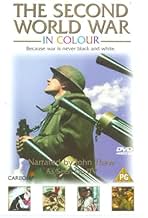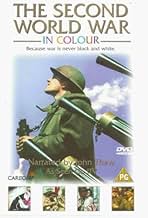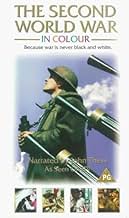अपनी भाषा में प्लॉट जोड़ेंThe Second World War In Colour [1999] is a seven-part documentary which reveals hours of previously unseen colour film of World War II. As almost all newsreel film was shot in black and whit... सभी पढ़ेंThe Second World War In Colour [1999] is a seven-part documentary which reveals hours of previously unseen colour film of World War II. As almost all newsreel film was shot in black and white, this DVD offers a completely new portrait of the war. Dramatic colour footage from as e... सभी पढ़ेंThe Second World War In Colour [1999] is a seven-part documentary which reveals hours of previously unseen colour film of World War II. As almost all newsreel film was shot in black and white, this DVD offers a completely new portrait of the war. Dramatic colour footage from as early as 1933 shows home movies of Adolf Hitler and his cohorts, the devastation wrought by... सभी पढ़ें
- 5 BAFTA अवार्ड के लिए नामांकित
- 7 जीत और कुल 9 नामांकन
फ़ीचर्ड समीक्षाएं
About all the major events which happened during the period 1936-1945 are included. For example the German invansion in Poland and France, the bombing of London, Pearl Harbor, the confrontation between the American fleet and the German U-boats, Stalingrad, the American invasions of the Japanese islands, D-day, the Holocaust, Japanese Kamikazes, Hiroshima, ... it's all there.
I recommend this documentary to everyone who is interested in WWII or to people who would like to know some historical background information on movies like "Saving Private Ryan" or "Das Boot".
After seeing this I say ==> bye bye black and white , hello color
This miniseries makes a point of presenting WWII in period color only, as opposed to the wealth of b&w material we have seen, e.g. the Why We Fight series. Most of it (maybe except the Soviet parade parts) are probably amateur films, silent and 16mm, I suppose.
The editing of such color rarities (few people could afford a film camera in the 1930s, and even less color film) is quite admirably done here, and shows many surprising sights, especially of wartime civilian life in France and Britain. Add to that the diary and letter readings, and even the background music - a very strong retelling, in all.
But what struck me most was the pairing - I got part 1 of this series on an add-on DVD from AudioVideoPhoto Bild, a German consumer magazine that I only buy for the DVD, and otherwise throw away mostly unread. The 2/2009 featured movie was American History X (with its own b&w vs. color contrast) , and Colour of War 1 was just thrown in as extra.. But it gave me much more food for thought to see the two as a double-feature: swastikas, images of Hitler, brutal violence, from two very different edges.
John Thaw's well-written narration is often interrupted by someone reading letters that were written at the front lines, or by observers at home. There are diary entries, sometimes moving. This material is drawn from British, Japanese, German, Polish, French, Russian, and American sources, though we see nothing of Japanese civilians. Two of the authors of those letters deserve special mention. Quentin Aanenson, a placid Midwesterner who piloted a P-47, writes dispassionately and with great insight about his experiences. If you can find his documentary, "A Fighter Pilot's Story," be sure to watch it. And Eugene Sledge was a corporal in the Marine Corps and fought at Peleliu and Okinawa, publishing his memoirs in 1981, and became a professor of biology. "With the Old Breed" is a generous and brutal book, not quite like any other in its genre.
Though the emotional element of that world-wide calamity is preserved, this can't really be considered a step-by-step history of World War II. Africa is hardly mentioned. Italy isn't mentioned at all, nor is Guadalcanal.
And most of the political juggling is missing, except for a couple of incisive observations in Thaw's narrative. I'll give an example. Here in America, as I write this, we are faced with intermittent "terrorist" attacks, as are some other Western nations. But we had a Big One on 11 September, 2001, that altered the skyline of New York City. Since then, whenever someone in power suggests moderation in our response to those who despise us, perhaps negotiating with our adversaries, poor Neville Chamberlain is brought up as an example of a coward who "appeased" the enemy and brought on the invasion of Poland. (As if, had Chamberlain declared war in Munich, there would have been no war.) Yet, as the narration points out, Chamberlain and his generation had already BEEN through the slaughterhouse that was World War I, and they had an excellent idea of what was at stake. Of course the point is obvious if you think about it, but few of us today think about it.
So, yes, the emotional content is powerful. Those piles of skin and bone in Buchenwald and Dachau. The little Okinawan girl sitting in rags and shivering all over. The tears of relief when the whole bloody affair ends. But it's "educational" too, and in a way that some of us now need more than ever.
क्या आपको पता है
- कनेक्शनEdited into Ten Minutes Older: The Cello (2002)
टॉप पसंद
विवरण
- रिलीज़ की तारीख़
- कंट्री ऑफ़ ओरिजिन
- भाषा
- इस रूप में भी जाना जाता है
- Krigets färger
- IMDbPro पर और कंपनी क्रेडिट देखें
- चलने की अवधि3 घंटे
- रंग




























